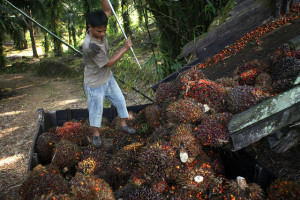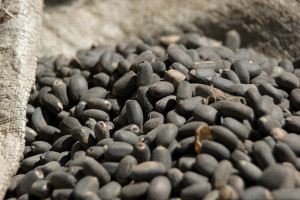
At the Renewable Energy Forum in Bali in October 2015, the World Agroforestry Centre and the Indonesian government agreed to strengthen research on renewable energy. Bioenergy will also have a more prominent role in the new phase of the CGIAR Research Program on Forests, Trees and Agroforestry, in connection with research on climate change and forests. With this in mind, Robert Finlayson spoke to Tony Simons, Director General of the World Agroforestry Centre, about wonder crops, the role of smallholders and the benefits of agroforestry for the production of bioenergy.
Bioenergy is certainly a buzzword. And the danger with buzzwords is that everyone can use them without having a clear idea what they really mean. How would you describe bioenergy?
Fuel is hydrocarbons and food is carbohydrates; similar molecules are at work to release energy. These molecules release energy that powers our transport and industries, lights our homes and also feeds our bodies. We see food as more than just calories or carbohydrates but also as appropriate nutrition to maximise health and an active life. So we must now learn to look at fuel as more than just the combustion of hydrocarbons but as also providing sustenance of livelihoods and environmental services.
An important part of achieving this can be found in something as common as a plant’s leaf. It is the best solar panel we have and, while not as efficient as photovoltaic cells, it has an extraordinary battery that outperforms any semiconductor thanks to the chlorophyll molecule, which converts sunlight into energy ready for us to harness.

The World Agroforestry Centre and the Indonesian government want to collaborate on research into renewables. Indonesia has ambitious plans in this area. ICRAF focuses a lot of its work on smallholders and their livelihoods. What would investment in bioenergy mean for them?
The Government of Indonesia plans to have 23% of its energy supplies from renewables by 2025, which also contributes to Sustainable Development Goal 7: Ensure access to affordable, reliable, sustainable and modern energy for all. It is, indeed, a great achievement that the world now has the 17 Goals and a common deadline of 2030.
What is needed, especially in a transitional economy like Indonesia, are policies that are harmonious with other parts of government, that are integrated across sectors and that are enforced. This is how you reduce risks for smallholders as well as large firms.
And whatever system, or systems, is decided, it needs to be attractive to investors, both big and small. The interplay between public and private institutions and smallholders is crucial.
But many rural communities are asking, “What about now?” To address all of these issues at once, we need a triple win on energy, livelihoods and land rehabilitation. How can the government convince villagers that renewable energy is the solution to their problems?
Trees should be seen as important contributors to reaching the bioenergy target. And agroforestry systems are a means for smallholders to not only produce energy but also food, medicines and building materials that improve their livelihoods and also contribute to carbon storage and emissions reduction.
In Sri Lanka, there are wood-fuelled gasifiers of 5–50 Kw. Tokyo Electric installed a 10 MW plant in Sri Lanka and another eight are commissioned. Wood biomass contributes over a third of primary energy in India.
Also read: Bioenergy boosted through international agreement in Bali

Indonesia already has problems of deforestation with oil palm production. Where will the land to produce renewable energy come from?
A recent report by the Scientific Committee on Problems of the Environment found that by 2050, only 50–200 million hectares of land would be needed to produce 20% of the planet’s primary energy from bioenergy. This isn’t a huge amount, especially given the large amount of degraded and under-used land in the world. So land availability isn’t the problem, but rather our land-use choices are.
Oil palm is has been linked to the destruction of forests and biodiversity, but it is also a very efficient bioenergy plant. So how do we balance the benefit and the risks from such a crop?
There have been problems for smallholders relying totally on a single crop for their livelihoods. If global prices for the commodity fall, as is the case in 2015, so do farmers’ incomes.
If we can diversify, we can improve the situation not only for farmers but for productivity, too. In Brazil, a seven-year experiment has been testing oil palm intercropped with trees and it is proving that such systems can indeed improve livelihoods while also meeting environmental and productivity goals.
In Indonesia, work by the World Agroforestry Centre with farmers and local governments in the province of Jambi in Sumatra has shown that oil palm can be successfully intercropped on peat with indigenous trees.
And there is the concept of ‘livelihoods’ insetting’. Insetting simultaneously addresses consumer concerns about oil-palm sustainability and industry concerns about productivity by embedding sustainable activities directly into a business’s supply chain, leading to the build-up of human capital in the communities involved and improved productivity and environmental dividends.

So what is the best bet to produce energy from plants?
We should not be fooled into thinking that one size fits all. There is the risk of looking for the magic solution, whether it be sugarcane, soy, Pongamia, Croton, Miscanthus, Nipa or any of the other candidates.
Experience with other ‘wonder’ plants shows that hype can replace scientific evidence and lead to many failures and disappointments. Choices should be based on solid evidence from experience in the field and include a full life-cycle analysis to ensure that greenhouse-gas reductions are not foiled by gains elsewhere.
We found that with Jatropha, for example, that its development wasn’t based on full carbon accounting and allowed biofuel-importing countries to ignore emissions caused elsewhere. The accounting systems are more complete now.
The plant’s development was also based on land grabbing and concession systems that didn’t respect local rights and decision-making processes. It helped some large players make money but didn’t provide opportunities for local livelihoods to support sustainable growth. In the move from fossil fuels to living fuels, we need to continue to enlighten investors and policy makers, empower local communities and energise action by government and all people interested in the bioenergy landscape.
So you advise against monoculture and ‘wonder crops’. Apart from creating the policy framework for a sustainable bioenergy sector, what else should the government keep in mind?
If the Government of Indonesia wants 23% of their energy from renewables by 2025, of which 10% should come from bioenergy, then those plants have to be in the ground before 2020. We need action to start now.
Further reading from Agroforestry World Blog:
Improving timber and non-timber products in Indonesia
Bioenergy for Indonesia means improving smallholders’ livelihoods and maintaining the environment
Sustainable bioenergy and the Sustainable Development Goals in Indonesia











